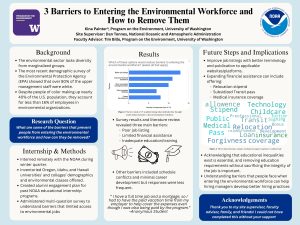3 Barriers to Entering the Environmental Workforce and how to Remove them
The environmental workforce lacks representation, including people from marginalized communities like Indigenous, disabled, and LGBTQ+ individuals. The purpose of this study was to find and understand the barriers that prevent underrepresented people from entering the environmental sector. During my internship with the National Oceanic and Atmospheric Administration, I conducted literature review of pre-existing research into the issue and distributed a survey to young professionals starting to enter their working careers to understand what prevented people from applying to environmental jobs. With my research, I found that financial barriers, poor job listings, and educational gaps were the largest barriers. Financial barriers include unpaid internships, low entry-level wages, and the high cost of education or relocation expenses. Poor job listings often use vague language or require unnecessary experience, making it hard for qualified applicants to apply. Gaps in education, such as inadequacies in environmental classes or mentorship opportunities, also prevent many qualified applicants from applying. Solving these barriers can lead to a more diverse workforce and create a better work environment while also being able to include more voices in how to restore the environment. By prioritizing equity and accessibility, organizations can not only attract diverse talent but also implement better environmental policies and projects. A more diverse workforce can lead to better collaboration, more creative problem-solving, and stronger connections to the communities being served.
